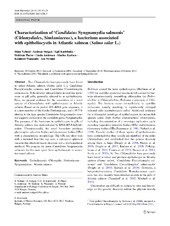Characterization of ‘Candidatus Syngnamydia salmonis’ (Chlamydiales, Simkaniaceae), a bacterium associated with epitheliocystis in Atlantic salmon (Salmo salar L.)
Nylund, Stian; Steigen, Andreas; Karlsbakk, Egil; Plarre, Heidrun; Andersen, Linda; Karlsen, Marius; Watanabe, Kuninori; Nylund, Are
Peer reviewed, Journal article
Published version
Permanent lenke
http://hdl.handle.net/1956/9453Utgivelsesdato
2015-01Metadata
Vis full innførselSamlinger
Originalversjon
https://doi.org/10.1007/s00203-014-1038-3Sammendrag
Two Chlamydiales have previously been found to infect Atlantic salmon (Salmo salar L.), Candidatus Piscichlamydia salmonis and Candidatus Clavichlamydia salmonicola. Both develop intracellularly in cyst-like inclusions in gill cells, generally referred to as epitheliocysts. Here, we present evidence for the association of a novel species of Chlamydiales with epitheliocystis in Atlantic salmon. Based on its partial 16S rRNA gene sequence, it is a new member of the family Simkaniaceae, and a 95.7 % identity to the type species Candidatus Syngnamydia venezia suggests inclusion in the candidate genus Syngnamydia. The presence of the bacterium in epitheliocysts in gills of Atlantic salmon was demonstrated by RNA–RNA hybridization. Ultrastructurally, the novel bacterium produces pleomorphic reticulate bodies and elementary bodies (EBs) with a characteristic morphology. The EBs are short rods with a terminal disc-like cap area, a sub-apical spherical vacuole-like electron-lucent structure and a post-equatorial nucleoid. We propose the name Candidatus Syngnamydia salmonis for this new agent from epitheliocysts in seawater-reared salmon.

